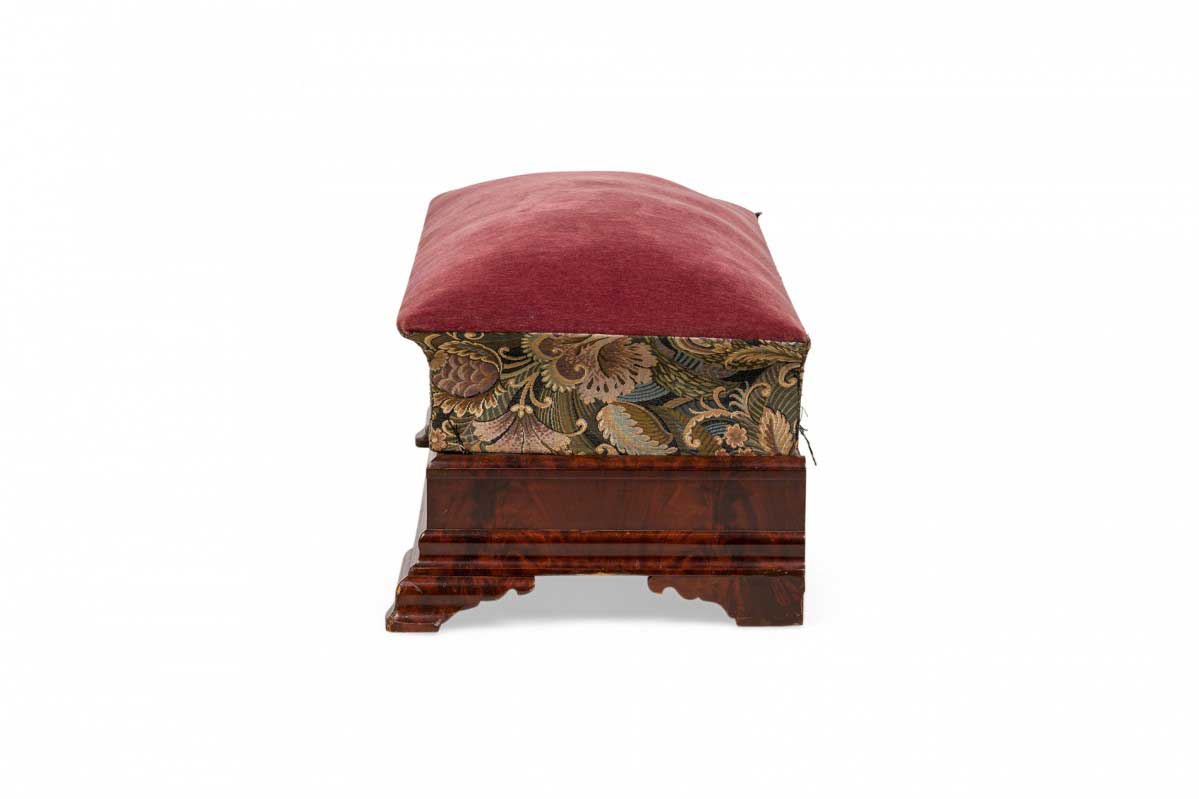X
{{ modalTitle }}
PLEASE FILL IN THE REQUIRED FIELDS.X
X
{{ modalTitle }}
Choose one of the options below.X
ITEM SUCCESSFULLY
ADDED TO PROJECT
American Empire Long Ottoman with Upholstered Burgundy Velvet and Tapestry Top
 American
American Empire
Empire Seating
Seating Ottomans & Footstools
Ottomans & Footstools
Newel Warehouse
32-00 Skillman Ave
Long Island City NY - 11101
 (212) 758-1970
(212) 758-1970
American Empire Long Ottoman with Upholstered Burgundy Velvet and Tapestry Top

Newel Warehouse
32-00 Skillman Ave
Long Island City NY - 11101
 (212) 758-1970
(212) 758-1970
 Seating
Seating Ottomans & Footstools
Ottomans & FootstoolsEmpire
A period of design during the reign of Napoleon I. It was most prevalent between 1800 and the late 1820s. It was considered the second wave of neoclassicism and marked a return to ostentatious design, a departure from the more conservative Directoire period that directly preceded it. It was intended to idealize the majesty of the French state and Napoleonic rule. Mahogany was the most popular wood during the period, and brass ornamentation and dark marbles were in vogue. Greek, Roman, and Egyptian motifs were also widely used. The style spread throughout Europe and appeared in America in some of Duncan Phyfe's work.
Mahogany
Mahogany is a straight grained hard wood with silky texture, ranging in color from dark brown to red. Furniture made from mahogany became popular in Britain from Mid-18th Century on, spreading throughout Europe.
Ottoman
An ottoman is a low, upholstered seat without back or arms. The ottoman was originally designed to be a footrest, but has come to serve many more purposes than just a place to rest your feet. Ottomans are often used as extra seating or as coffee tables. Many ottomans come with a hinged top which makes them perfect for storing belongings, such as blankets or electronics.
Veneer
A wood finishing technique in which thin sheet of fine wood is applied to a the surface of a coarser wood or other structural material for decoration. Veneer is used to give furniture pieces a finer, more pleasing appearance. It was first used in ancient Egypt, classical Greece, and Rome, but did not appear again until the 17th Century in the Netherlands.
Empire
A period of design during the reign of Napoleon I. It was most prevalent between 1800 and the late 1820s. It was considered the second wave of neoclassicism and marked a return to ostentatious design, a departure from the more conservative Directoire period that directly preceded it. It was intended to idealize the majesty of the French state and Napoleonic rule. Mahogany was the most popular wood during the period, and brass ornamentation and dark marbles were in vogue. Greek, Roman, and Egyptian motifs were also widely used. The style spread throughout Europe and appeared in America in some of Duncan Phyfe's work.
Mahogany
Mahogany is a straight grained hard wood with silky texture, ranging in color from dark brown to red. Furniture made from mahogany became popular in Britain from Mid-18th Century on, spreading throughout Europe.
Ottoman
An ottoman is a low, upholstered seat without back or arms. The ottoman was originally designed to be a footrest, but has come to serve many more purposes than just a place to rest your feet. Ottomans are often used as extra seating or as coffee tables. Many ottomans come with a hinged top which makes them perfect for storing belongings, such as blankets or electronics.
Veneer
A wood finishing technique in which thin sheet of fine wood is applied to a the surface of a coarser wood or other structural material for decoration. Veneer is used to give furniture pieces a finer, more pleasing appearance. It was first used in ancient Egypt, classical Greece, and Rome, but did not appear again until the 17th Century in the Netherlands.
Empire
A period of design during the reign of Napoleon I. It was most prevalent between 1800 and the late 1820s. It was considered the second wave of neoclassicism and marked a return to ostentatious design, a departure from the more conservative Directoire period that directly preceded it. It was intended to idealize the majesty of the French state and Napoleonic rule. Mahogany was the most popular wood during the period, and brass ornamentation and dark marbles were in vogue. Greek, Roman, and Egyptian motifs were also widely used. The style spread throughout Europe and appeared in America in some of Duncan Phyfe's work.
Mahogany
Mahogany is a straight grained hard wood with silky texture, ranging in color from dark brown to red. Furniture made from mahogany became popular in Britain from Mid-18th Century on, spreading throughout Europe.
Ottoman
An ottoman is a low, upholstered seat without back or arms. The ottoman was originally designed to be a footrest, but has come to serve many more purposes than just a place to rest your feet. Ottomans are often used as extra seating or as coffee tables. Many ottomans come with a hinged top which makes them perfect for storing belongings, such as blankets or electronics.
Veneer
A wood finishing technique in which thin sheet of fine wood is applied to a the surface of a coarser wood or other structural material for decoration. Veneer is used to give furniture pieces a finer, more pleasing appearance. It was first used in ancient Egypt, classical Greece, and Rome, but did not appear again until the 17th Century in the Netherlands.


















